Longtime fans of our Channel and readers of our website are sure to know that we’re big fans of pocket squares here at the Gentleman’s Gazette, that’s because it’s a small accessory that makes a big difference! Not only will wearing a quality pocket square immediately give a visual signifier that you care about your appearance but also as a man of classic style, it will allow you one more point of experimentation with colors, patterns, and textures in your outfits.
Even better, you don’t have to do a lot of fussing with them to put one into your pocket, they can take just 10 seconds or even less to fold and there are, of course, a multitude of different pocket square folds out there.
Something to keep in mind though is that not all pocket squares are created equal; there are definitely squares out there that are made from lower quality materials and with lower qualities of construction and the discerning gentlemen will be able to notice these details easily.
As an example of this principle, at the recent 2019 Menfluential Conference in Atlanta, one fairly big-name menswear YouTuber wore what appeared to be a white pocket square at first but upon closer inspection, was actually just a cheap piece of white fabric that had been sewn into the breast pocket of his suit. Now, of course, we’re not going to name any names here but this story just illustrates the principle that if you’re wearing something cheap in your breast pocket, it will show to those who care.
What factors should you be looking for in choosing a quality pocket square then? Well, there are basically three big ones; the material used, the size of the pocket square, and how the edges are stitched.
Pocket Square Construction Materials
Silk
We will start with silk which is a versatile classic. Silk squares are often going to be particularly compact in your pocket and they’re good for unstructured folds like a puff fold, for example. However, there can be downsides to a silk square in that because it is so smooth. If it’s too small, it will easily slide down into your pocket and be unseen.
Linen
Linen pocket squares are also extremely versatile. Often, they’ll have more structured edges but soft and supple centers so they’ll be easy to fold into both structured folds like a crown fold but also will do well with unstructured folds. As linen’s texture is a slight bit more coarse than silk, you probably won’t have as much of an issue with a linen square falling into your pocket but if it’s too big, it will create added bulk in your pocket which can look unsightly. Linen does crease more easily than some other fabrics but most discerning gentlemen appreciate the sophisticated way in which linen creases. Therefore, having a bit of creasing in your linen pocket squares isn’t really going to be seen as a problem.
Wool
Woolen pocket squares are truly for the connoisseur. They can look particularly smart when worn with other heavier and warmer fabrics in the cold months, say for example, a tweed sport coat. Prices of wool squares can vary widely, however, depending on the type of wool used and similarly to linen, if the square is too big, it’s going to add a lot of unsightly bulk to your pocket.
Cotton
Cotton pocket squares are available as well but overall, they’re a less refined option. While they are fairly durable and easy to wash, they don’t hold folds very well and they wrinkle in a less attractive way than linen does. Therefore, cotton squares are best used not as a pocket square for your breast pocket but rather as a handkerchief for one of your trouser pockets or elsewhere on your person because they are so durable they’re better for wiping sweat from your brow, cleaning up messes, and so on.
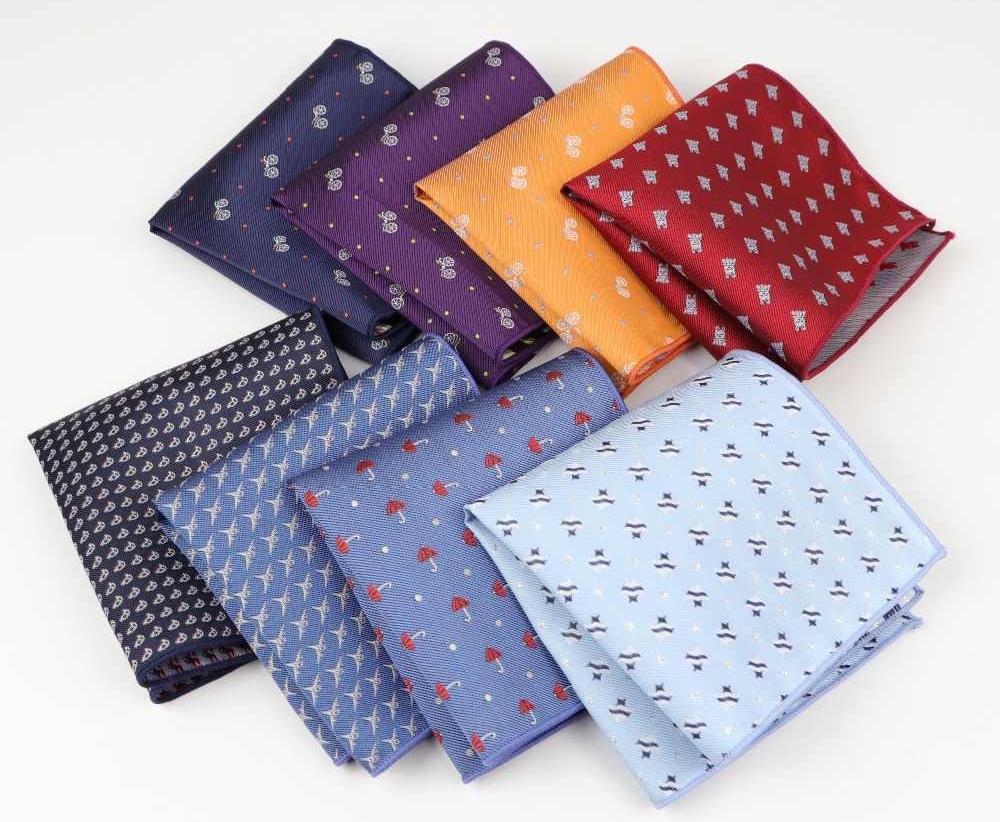
Polyester
Polyester pocket squares are inexpensive, lightweight, and durable but they are best avoided. They often look overly shiny in their finish and are almost always machine stitched. Also, removing stains from synthetic fabrics isn’t an easy task.
Blends
Additionally, you can also find blends of multiple types of fabrics that will carry the characteristics of each type. For example, a silk wool blend will be handsome visually and will also allow for multiple different types of folds both structured and unstructured. In general, we recommend pocket squares in silk, wool, linen, and blends thereof. Cotton can work in summery situations but it and polyester are both best avoided.
The Best Pocket Square Size For You
In the broad strokes, the answer is that it depends largely on the fabric used. Almost all squares are sized so that they yield the most fabric possible from the original fabric bolt.
For example, if you have a fabric that is 70 centimeters or about 27 and a half inches wide, it’s cut in half leaving you with 35-centimeter squares that are more like 33 centimeters, once the edges are rolled. Or if the fabric happens to be 160 centimeters or 63 inches, it will often be cut into roughly 40-centimeter squares. This, however, can present a potential problem. Depending on the size of the square cut, you can either end up with a square that is too small and falls into your pocket or too large and presents extra bulk.
The Fort Belvedere Promise
At Fort Belvedere, we keep these considerations in mind when producing our own pocket squares. Each fabric is tested in 8 different sizes and then worn to determine what the best size for any given fabric will be. This means that we do have to work with higher quantities of raw materials than we would if we were only considering efficiency as our top priority. For example, if we were going to make squares that are forty centimeters in size, this means that we would only be half as efficient when working with a 70 centimeter roll of fabric but all in all, we do this to achieve the ultimate goal of a pocket square which is to look polished and put together in the wearer’s pocket.
So in general, there’s no universally right size for a pocket square but just know that thinner fabrics should be larger and thicker fabrics should be smaller.
Types Of Pocket Square Edges
Now with materials and sizing out of the way, let’s discuss the various different types of edges a pocket square can have and the pros and cons of each style.
First, a few general notes on this topic depending on the type of pocket square fold you choose, the edges of your square may be the most visible part of it, therefore, if you’re wearing a pocket square with cheap machine stitched edges, it will fray with repeated wearing and won’t look attractive. Also, there’s an inherent difference in edge types depending on the fabric of the pocket square in question.
Silk squares, as well as those made from polyester, often have soft and supple edges. These are good for unstructured puff folds but having more precise folds often won’t be able to be achieved as well. Conversely, pocket squares made from linen wool and cotton often have stiffer and more structured edges so having a pocket square fold with points or other details is more easily achieved. Regardless of the fabric type, however, the principal character of a pocket square’s edge will come from the type of stitching that’s used.
The Hand-Rolled Edge
As such, we’ll start our overview of these stitching types with the gold standard; the hand rolled edge. Also called a rolled edge, rolled hem, or rollover stitch, the most refined pocket squares are going to feature edges that are hand rolled into a tight and tubular edge and then also stitched by hand. Typically, you’ll see about five to six stitches to an inch or a stitch every half centimeter or so, though this can vary depending on the square. As you might imagine, squares with a higher stitch density are going to take longer to produce than those with a lower stitch density and the lower the number of overall stitches, the looser the edge is going to be. Given that it is handmade, the stitch will be slightly uneven but this is a plus, it gives it a unique and artisanal finish.
Hand stitching can also be done in a variety of styles, of course, including a straight stitch or an X stitch as well as many others. In the particular example of X stitching, you won’t see it very often as even X stitching done by hand is relatively difficult to achieve and takes quite a bit of time. At Fort Belvedere, however, we pride ourselves in the fact that you can find some of the highest quality hand X stitched pocket squares on the market today.
One additional distinction to note with hand rolled pocket square edges, if the edge is rolled on to the front side of a pocket square, which is to say, the sign that has the pattern printed or woven onto it, this is known as a French rolled hem. However, if the edges rolled to the back side of the pocket square, this is known as an Italian rolled hem. Whichever style of rolling you prefer is simply a personal preference and one isn’t any more formal than the other. In the case of the French rolled hem, it’s a particular style of many scarves and other garments made by Hermes. And it’s worth noting that the precision and craftsmanship involved in a hand-rolled pocket square edge will probably mean that the resulting square has a bit of a higher price tag but as with most things, you get what you pay for.
Machine-Stitched Edge
Meanwhile, mass-market retailers often aren’t going to want to pay for the additional labor that goes into hand stitching pocket square edges. As such, most mass-produced squares that you’ll find on the market today have machine stitched edges. There are a number of different types of machined edges as well. Simplest of these is the parallel edge which is flat and simple with only one line of stitching and doesn’t contain much character or dimension in the pocket square’s edge and while the so-called Z shaped edge features a bit more character and interest in its stitching, the edges of the fabric itself are still going to be relatively flat and lifeless.
One machined edge style that does have some value is the embroidered or embroidery edge which features a tight spiral of thread running all around the edge of the square. Even so, a skilled artisan could probably achieve this same type of stitch by hand and it would be a more superior product overall. Finally, there are also machined edges that attempt to replicate the style of a hand-sewn edge, however, you’ll still be able to see that the edge isn’t actually hand-sewn and this replication has a number of disadvantages.
Firstly, machine stitched edges will be more visible and more uniform than a hand sewn edge. In fact, they’ll be almost too uniform, symmetrical, and perfect. Similar in the sense to the perfection you’d find in a pre-tied bow tie. Secondly, even though specially designed sewing machines are often used to roll the edge of the fabric over, you can still tell that it was done by a machine as the fabric will have had to pass under presser feet on the sewing machine and will thus be a little bit flatter than it would be if it were truly hand rolled. Finally and perhaps most crucially here, a machine stitched edge is probably going to feature thread that is slightly looser and thus more prone to snagging, coming loose, and ruining the pocket square.
What Sets The Hand-Rolled Edge Apart
So those are the different types of edges covered. You might not be totally sold on the superiority of the hand rolled edge though you might be wondering what sets the hand rolled edge apart aside from the additional labor that’s put into it.
Put simply, a pocket square with a hand-rolled edge is going to drape, fold, and puff better than a machine rolled edge square will. This is because hand-stitched edges are a little bit more naturally malleable and therefore can be contorted into various different shapes more easily. An additional plus that elevates the hand rolled edge is the presence of mitered corners on the square which meets at a 45-degree angle and thus has less bulk when they’re folded together.
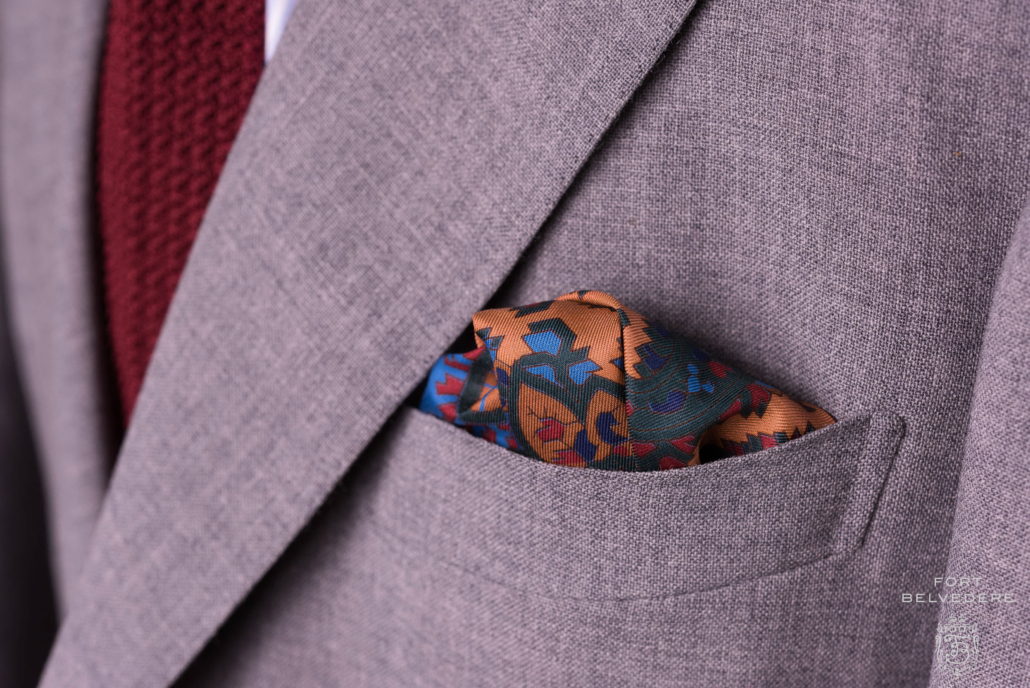
Meanwhile, a square with machined edges is going to often just have the fabric folded over itself multiple times at the corners creating excess bulk. Also, not only are mitered corners slimmer in your pocket but they’re also going to be more resistant to wear and tear over time.
To play devil’s advocate for a moment, there certainly do exist handmade pocket squares with hand rolled edges that are made sloppily and might be of inferior quality to a machine made pocket square. However, as long as you’re sourcing your pocket squares from a reputable seller, you can be almost guaranteed that anything handmade is going to be of superior quality to something made by a machine.
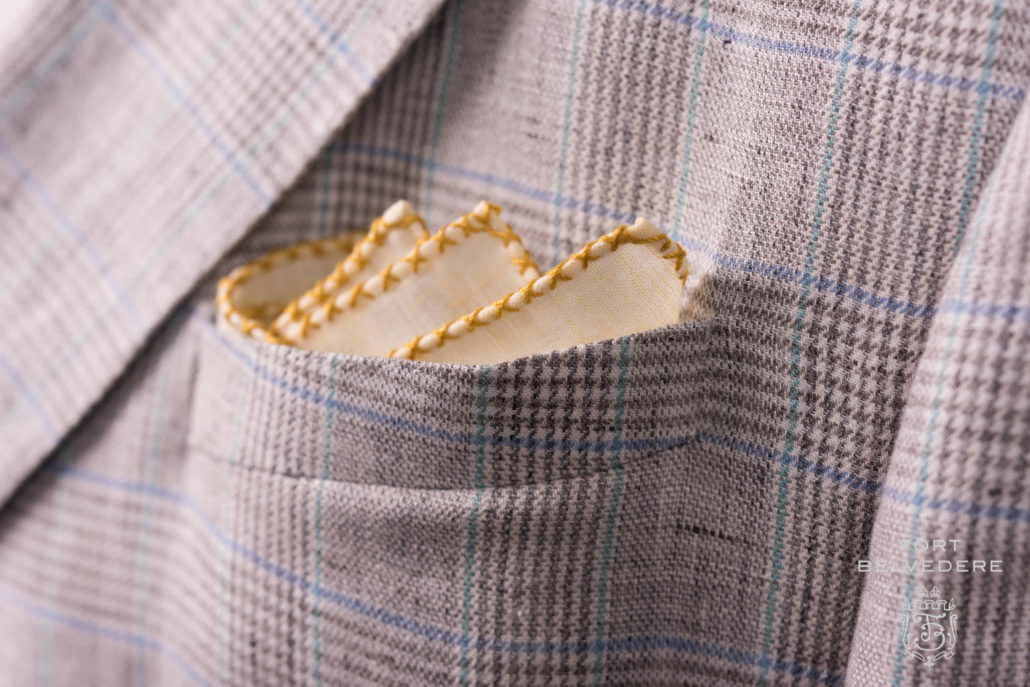
To fully cement the quality of the hand-rolled pocket square edge then, let’s take a look at a few examples from Fort Belvedere. All Fort Belvedere pocket squares are made from either silk linen or silk-wool blends and they all feature hand rolled edges. Some of these edges are going to feature straight stitching which of course is also done by hand and some of the squares are going to feature the more playful X stitch also done by hand. Additionally, squares that feature woven designs like polka dots or playing card suits, for instance, are going to be hand embroidered by skilled artisans taking more time and attention to detail. Specifically, X stitching by hand can take almost twice as long as straight stitching would and hand embroidery can take up to three times longer. Still, we think this additional time put in is worth it in the end product. The final pocket square is guaranteed to be a unique piece with a handmade character. In other words, a true mark of a gentleman.
CONCLUSION
As you can see then, selecting a pocket square to wear with your ensembles does require some attention to detail; the materials you prefer to wear each have their pros and cons and of course, you have to choose the right size but the benefits of a hand-rolled edge and hand-stitched edge are clear.


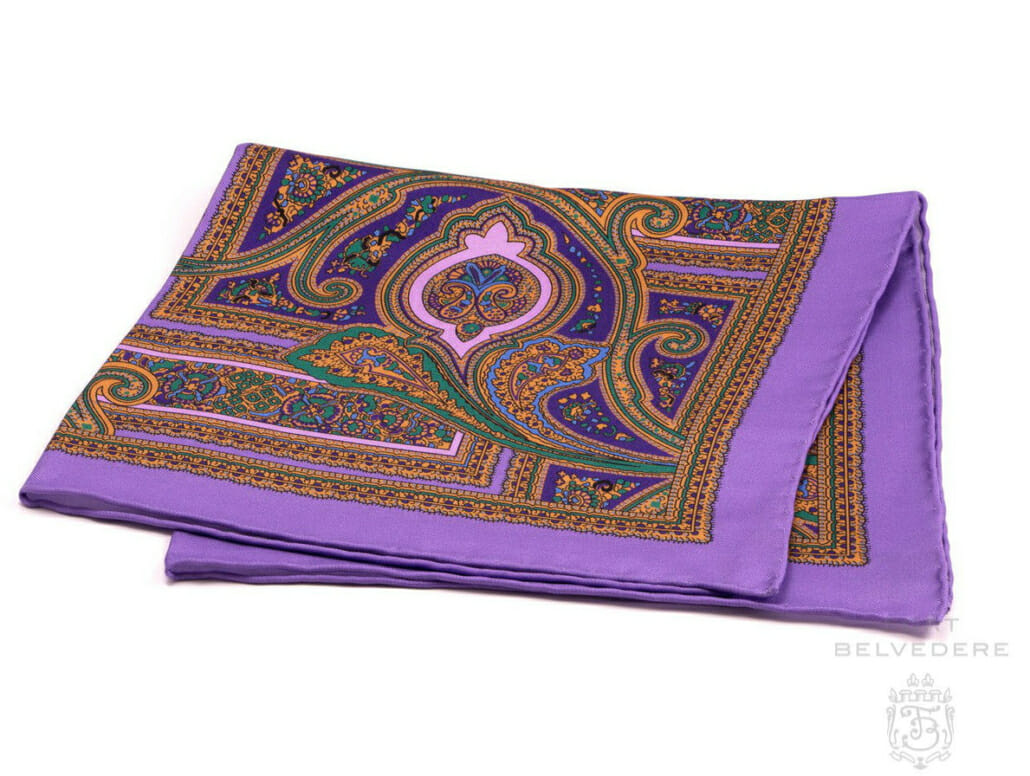
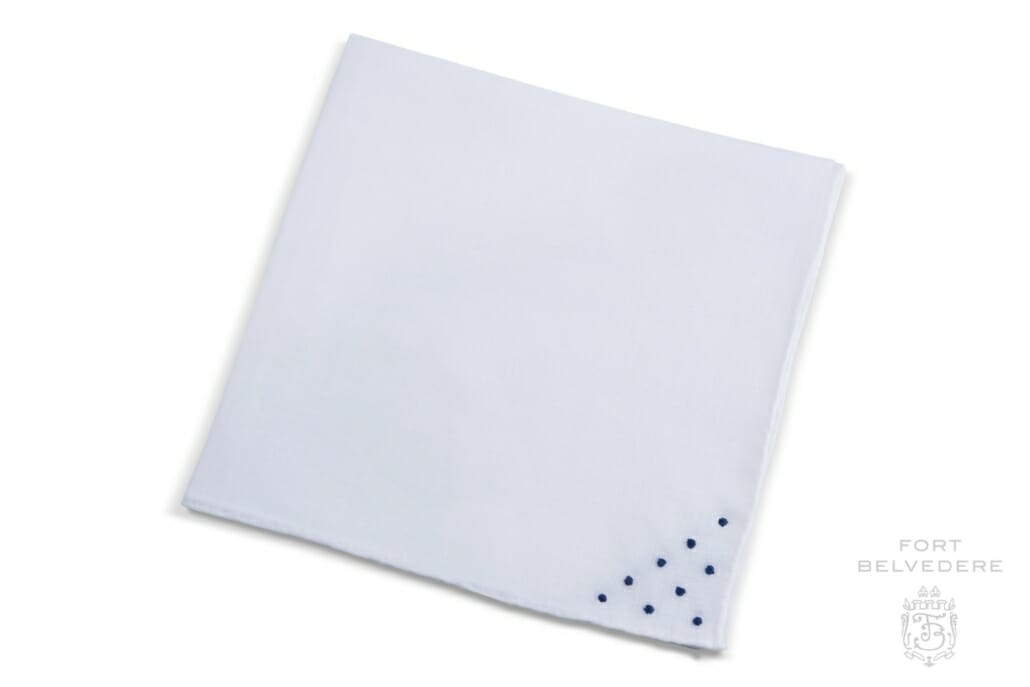
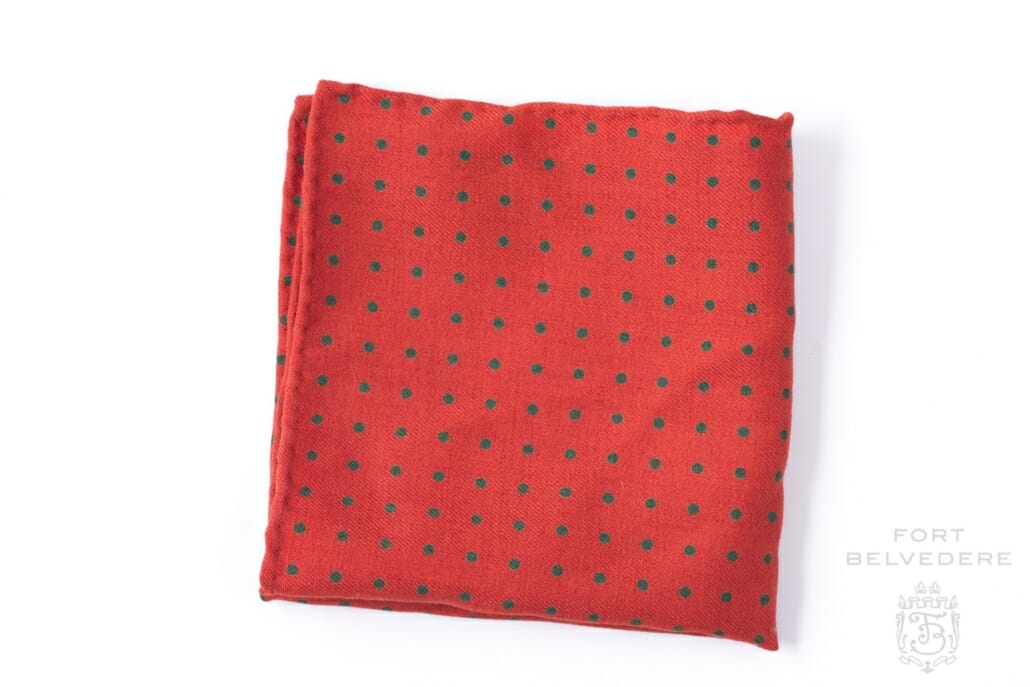
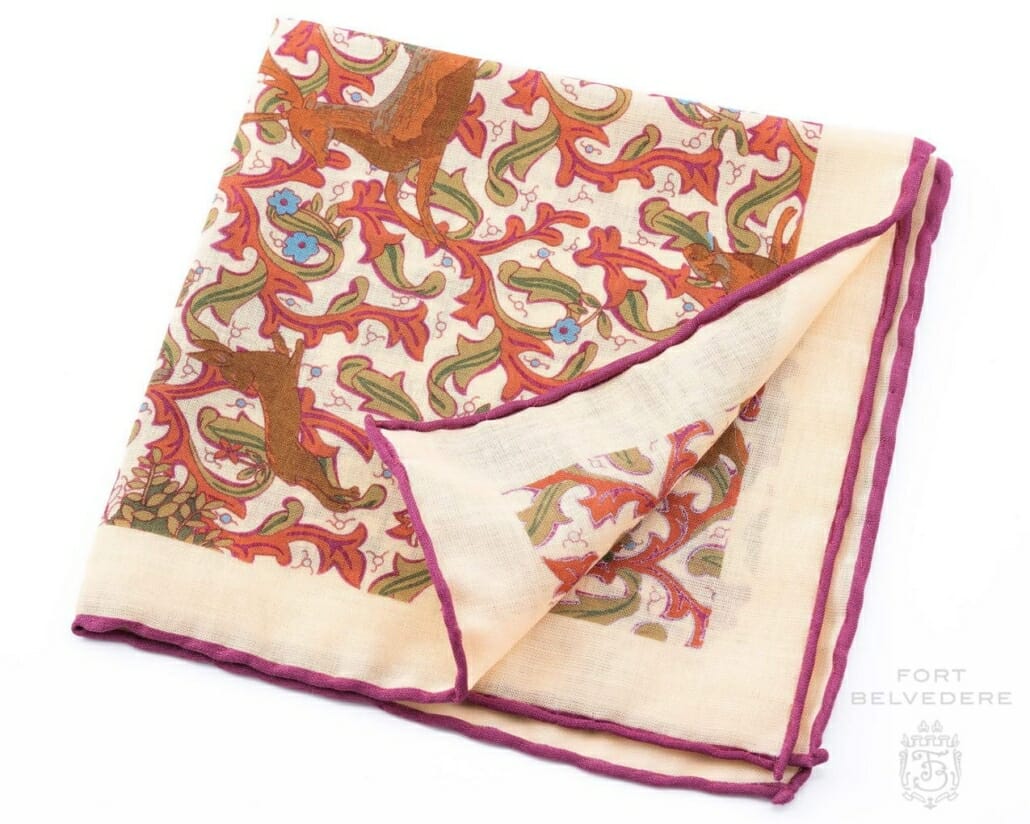
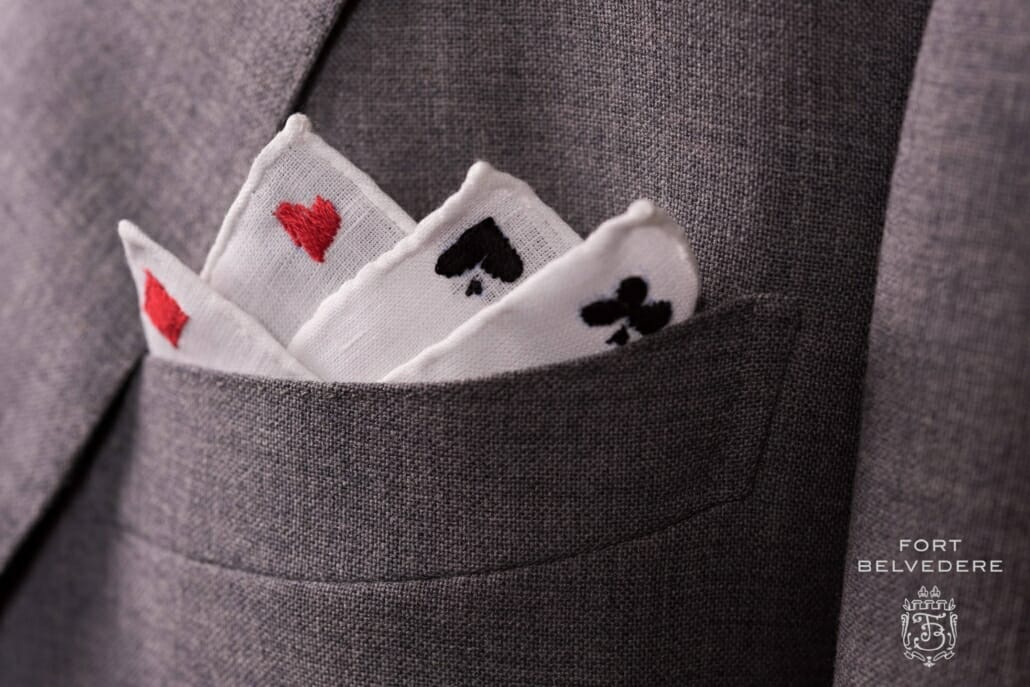
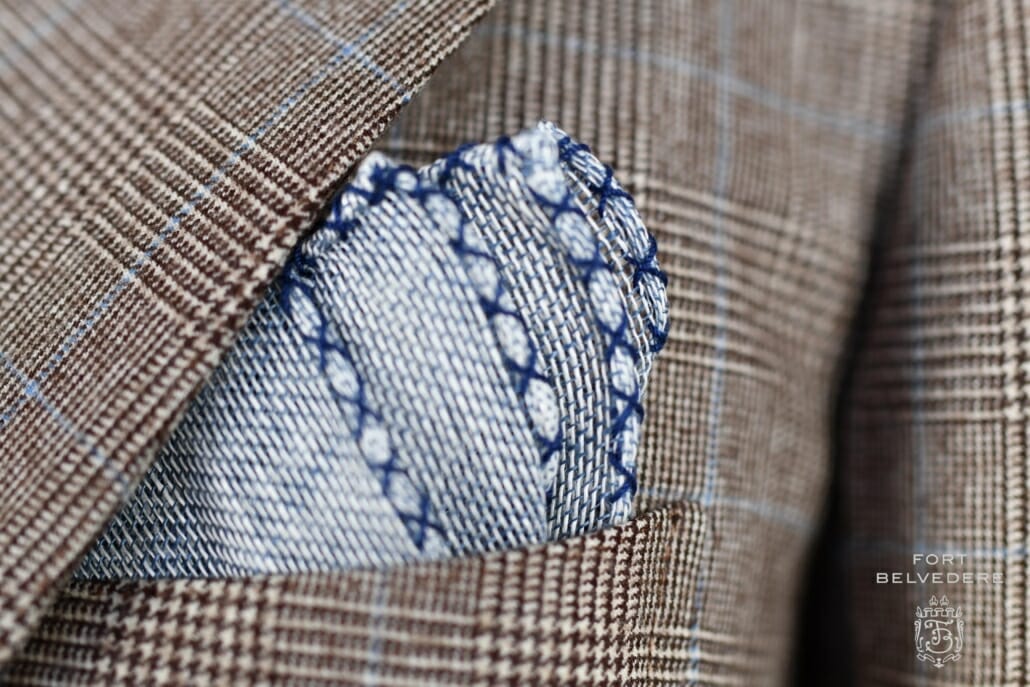
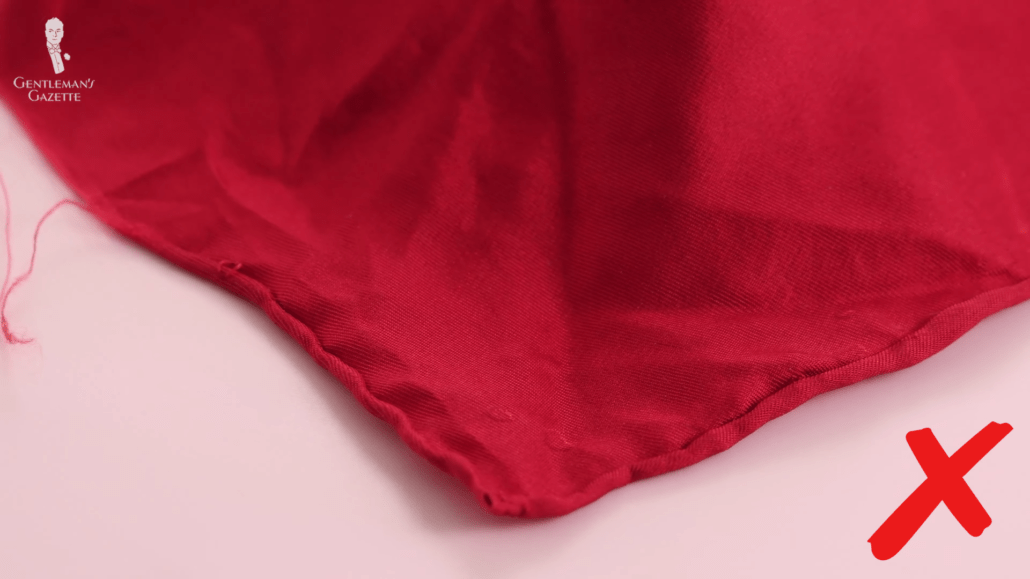
The proportion of touting of Fort Belvedere products to general information in this video is unattractive.
The size issue has not really been addressed. There has to be an advisable ‘minimum’ size irrespective of the material used, even a guideline would be better than suggesting there is no standard size. Surely with all of your experience, a target/acceptable size could be put forward, after all, surely your website is aimed at giving the right image. I feel that this article lets itself down by glossing over size especially given the pitfalls of too little or too much fabric.
I never thought of that.
As long as it doesn’t match a tie being worn, Imho any pocket square adds to an outfit. Of course a few may notice the difference with a hand rolled quality material but most won’t.
should i wear suit without pocket square?